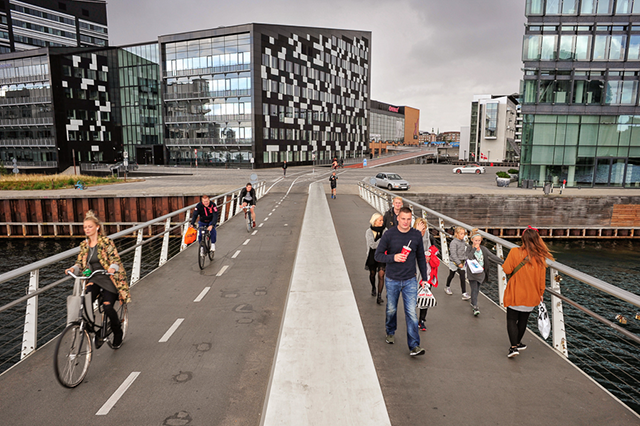
Does placemaking help democracy?
Above: Study group members discuss ideas to take home from Copenhagen as a fly fisherman practices casting. Credit: Torbjörn Larsson/Knight Foundation.
Planning, designing and managing public spaces with human beings squarely at the center of the picture produces remarkably livable cities and economic growth. Does it also strengthen democracy by bringing people together to address shared issues?
Related Links
“Want to build a bikeable city? Focus on those who don’t bike” by Andrew Sherry on Knight Blog (10/10/14)
“The first rule of livable cities: pedestrians first” by Andrew Sherry on Knight Blog (10/08/14)
“Creating a more connected Charlotte, N.C.” by Susan Patterson (09/09/14)
“Does placemaking help democracy?” by Andrew Sherry on Knight blog (08/29/14)
“Study tour gets street-level view of how Copenhagen reinvented itself”by Andrew Sherry on Knight blog (08/25/14)
“‘Knight Cities’- A conversation with Gil Penalosa on building better communities” by Carol Coletta on Knight blog (08//20/14)
“Teams from Knight communities to travel Scandinavia on livable cities tour” by Carol Coletta on Knight blog (07/25/14)
It’s an important question for Knight Foundation, which supports informed and engaged communities because we believe they help democracy to thrive. Most city planners, architects and others involved in placemaking tend to speak primarily in practical terms, though: pedestrian-friendly streetscapes, grids of bike paths, programming in parks.
Riccardo Marini, a director of Gehl Architects, spoke for a full morning on the practicalities of placemaking projects to more than 30 people on a late August study tour to Copenhagen organized by 8-80 Cities and sponsored by Knight. But when pressed to say what was at the core of the work, he didn’t hesitate.
“It’s a about power to the people. Democracy is a beautiful thing,” Marini said.
There is little data to show whether livable cities – with more interaction in public places – produces higher voting rates, often used as a barometer of engagement. But Marini clearly was not defining democracy so narrowly. His tyrants include outdated, unquestioned regulations on matters such as traffic flow, as well as silos among municipal departments.
“Bureaucracy is the enemy of democracy,” he said.
In essence, Gehl’s placemaking methods resemble the human-centered design approach that has revolutionized product development: consult widely, build lightly, test, incorporate feedback. But most significantly, put the individual human and his or her needs at the center of planning — not the automobile, fire truck or big-box store.
The consultative process used in placemaking bears more than a passing resemblance to democracy, especially in light of low voter turnout in U.S. elections. Marini said Gehl starts with broad surveys of how people use and want to use spaces. The data comes from asking questions and simply observing what people do. The results, which are used to kick off a dialogue with officials and residents, represent a high level of participation.
“When people start seeing their ideas turning into something, suddenly you have a degree of trust that didn’t exist before. You need it, because you can only do these projects if the majority of the people want to make a change,” said Marini.
Across the Oresund Bridge in Malmo, Sweden, the study tour saw another example of bottom-up consultation. As a new playground was being built in the low-income, mainly immigrant Rosengard neighborhood, the planners hired local teenage girls to help with both design and programming. The goal? To help balance the fact that new playgrounds tend to immediately fill up with boys and soccer balls. The result was a “Dance & Chill” space, with speakers that could be controlled from anyone’s iPhone.
Working with Gehl, the city government in Malmo is also bringing more buses, trains and bike paths to better connect the center city to Rosengard, where local youths and police clashed in 2009-2010. Despite its wide, tree-lined boulevards, its residents were isolated from the city and from each other by the cityscape; urban planning is being used to integrate them into the city.
The connection between human-scale cities and democracy is most visible when it’s not there, for example in brutalist, Soviet-style architecture that testifies to power, not people. In the United States, the challenge that many study group members may face when they return is the cult of efficiency, which often translates into moving as many cars through downtown as quickly as possible.
But for the people who invented democracy, the connection with the city was integral. The Ancient Greek polis, or city-state, was designed to encourage communal activity, and specifically political activity for those with the right to participate. In fact, Aristotle believed that only through participation in the city could man fully realize his potential. The practice of democracy, in that perspective, could not be closer to home.
Andrew Sherry is vice president of communications at Knight Foundation.

Photo: Pedestrians and cyclists have their own bridge, in a glitzy, formerly industrial part of Copenhagen. Credit: Torbjörn Larsson/Knight Foundation.
Recent Content
-
Community Impactarticle ·
-
Community Impactarticle ·
-
Community Impactarticle ·



